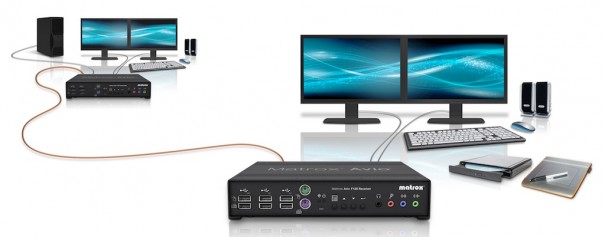Matrox Avio F125: USB-compatible dual fiber video KVM extenders 2.0
Matrox Avio F125 KVM Extension Solution Enables Compression- and Latency-Free Transmission Over a Distance of Up to 4 Km via a single fibre optic cable.
The multinational Matrox Graphics has developed a fiber optic KVM extender, called Avio F125, that allows you to zoom out dual HD video devices, keyboard, mouse, Stereo analog audio and USB 2.0 Workstation.
Avio F125 provides flexible connectivity options. Its transceiver pair extends two single-link DVI video signals (2×1.920×1.200) or a dual-link DVI signal (2.560×1.600 or 4,096×2.160), as well as various USB devices 2.0 from the host PC at a distance of four hundred meters via a multimode cable and 4 Km with a single-mode cable.
 This extender has the ability to transmit all signals without any compression or latency with a single LC-LC duplex fiber optic cable.
This extender has the ability to transmit all signals without any compression or latency with a single LC-LC duplex fiber optic cable.
Designed for high-performance environments, Avio F125 offers smooth video and graphics playback, making it the ideal solution for issuance, post, Professional AV Systems, Industrial Process Control, 3D design and visualization and military environments.
Matrox Graphics' Director of Business Development, Caroline Injoyan, notes that this development "is the latest addition to our successful KVM product line, designed to meet our customers' need to extend USB devices 2.0 high-speed digital video signals in demanding environments”.
 The Avio F125 KVM extender takes advantage of the full bandwidth of 10 Gbps that offers today's fiber optic technology and transmits all data uncompressed and with zero latency, delivering optimal performance from a remote desktop.
The Avio F125 KVM extender takes advantage of the full bandwidth of 10 Gbps that offers today's fiber optic technology and transmits all data uncompressed and with zero latency, delivering optimal performance from a remote desktop.
In this sense, with the Avio F125 extender the user can transmit signals from their system through a single fibre optic cable taking advantage of the greater bandwidth available on the network, as well as play HD video, 2K and 4K evenly and without frame or quality loss.
This solution, Easy to deploy without the need for software and on any operating system, It also reduces overall installation costs with fewer cables to transmit multiple signals.
You liked this article?
Subscribe to our Feed And you won't miss a thing.















